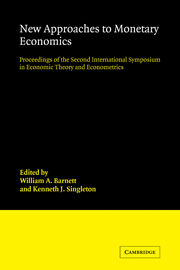 New Approaches to Monetary Economics
New Approaches to Monetary Economics Book contents
- Frontmatter
- Contents
- Editors' introduction
- List of contributors
- Part I Transactions motivated monetary holdings in general equilibrium
- Part II Financial intermediation
- Part III Monetary aggregation theory
- Part IV Issues on aggregate fluctuations
- 12 Asset prices in a time-series model with disparately informed, competitive traders
- 13 Nominal surprises, real factors, and propagation mechanisms
- 14 A rational expectations framework for short-run policy analysis
- Part V Theoretical issues in the foundations of monetary economics and macroeconomics
13 - Nominal surprises, real factors, and propagation mechanisms
Published online by Cambridge University Press: 04 August 2010
- Frontmatter
- Contents
- Editors' introduction
- List of contributors
- Part I Transactions motivated monetary holdings in general equilibrium
- Part II Financial intermediation
- Part III Monetary aggregation theory
- Part IV Issues on aggregate fluctuations
- 12 Asset prices in a time-series model with disparately informed, competitive traders
- 13 Nominal surprises, real factors, and propagation mechanisms
- 14 A rational expectations framework for short-run policy analysis
- Part V Theoretical issues in the foundations of monetary economics and macroeconomics
Summary
Introduction
A predominant focus of macroeconomic research in the last ten years has been on the origins of the business cycle. In particular, it has been popular to view the business cycle as arising from surprise movements in aggregate demand and to argue that these impulses are transmitted to real activity through movements in the price level. In order to generate empirically relevant fluctuations, however, such models must incorporate mechanisms to propagate price surprises over time. That is, to replicate economic fluctuations, it is necessary to transform serially uncorrelated price surprises into serially correlated macroeconomic time series. Unfortunately, despite the large amount of effort devoted in recent years to this type of equilibrium business cycle modeling, relatively little attention has been focused on isolating the empirically important propagation mechanisms.
More recently, we have pursued a line of research that we call “real business cycle theory,” in which disturbances are propagated over time as a result both of economic agents' desire to smooth commodity profiles and capitalistic production with rich intertemporal substitution opportunities. To date, however, these models incorporate only real supplyside or technological disturbances, abstracting from real demand-side influences (such as government spending) or nominal shocks. Nevertheless, the results on propagation mechanisms appear to be relevant for more fully developing the monetary theories of business fluctuation discussed above.
Of course, interest in propagation mechanisms is not new. Indeed, it was the major focus of many of the interwar business cycle theorists.
- Type
- Chapter
- Information
- New Approaches to Monetary EconomicsProceedings of the Second International Symposium in Economic Theory and Econometrics, pp. 273 - 292Publisher: Cambridge University PressPrint publication year: 1987
- 7
- Cited by


